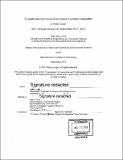An algebro-geometric study of two models of quantum computaiton
Author(s)
Lorgat, Raeez
DownloadFull printable version (2.615Mb)
Other Contributors
Massachusetts Institute of Technology. Department of Electrical Engineering and Computer Science.
Advisor
Peter W. Shor.
Terms of use
Metadata
Show full item recordAbstract
We investigate geometric aspects of two models of quantum computation: starting with i. the computational complexity of the particle excitations of topological phases of matter in the restricted model of a Topological Quantum Field Theory in the sense of Turaev before leading to ii. where in analogy with ideas of Nielsen et. al., we propose and study a geometric model for grover's search algorithm. i. presents fundamental results in the mathematics and physics literature on conformal field theory as a model for quantum computation, phrased within the algebraic framework of the theory of tensor categories. Our main questions are 1. how does the computational power of these excitations change as a function of the genus of a fixed 2-dimensional space-time? and 2. independent of any particular space-time, what structural properties of a TQFT govern its computational power? When restricted to a space-time with space-like degrees of freedom represented by a smooth surface of genus g, we answer the first question by observing a q⁹-fold degeneracy in the ground state of the TQFT resulting from the presence of abelian anyons with exchange statistics a q-th root of unity. Such a resource is a topologically fault-tolerant quantum memory. The abelian character of the emergent particle statistics leads us to answer the second question via an algebraic realization of non-abelian anyonic excitations in the language of unitary modular tensor categories. Subsequently, ii. studies the quantum mechanical evolution of a particle within the Schröedinger wave-function formalism of quantum mechanics: our primary result is a purely geometric proof of the optimality of Grover's Search Algorithm on n qubits obtained via a study of the geometric structure of a homogenous space for the Unitary group of transformations acting on a single qubit.
Description
Thesis: M. Eng., Massachusetts Institute of Technology, Department of Electrical Engineering and Computer Science, 2017. Cataloged from PDF version of thesis. Includes bibliographical references (pages 39-40).
Date issued
2017Department
Massachusetts Institute of Technology. Department of Electrical Engineering and Computer SciencePublisher
Massachusetts Institute of Technology
Keywords
Electrical Engineering and Computer Science.